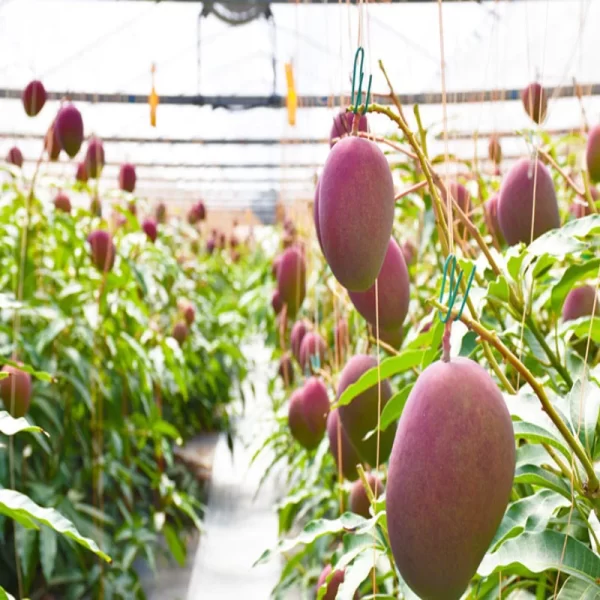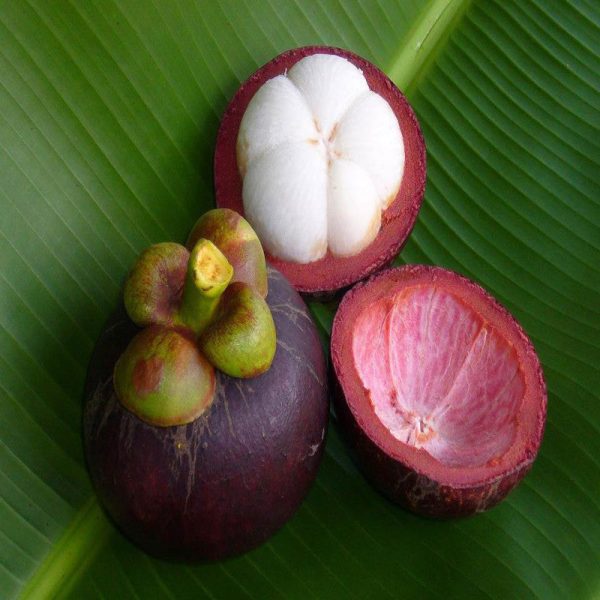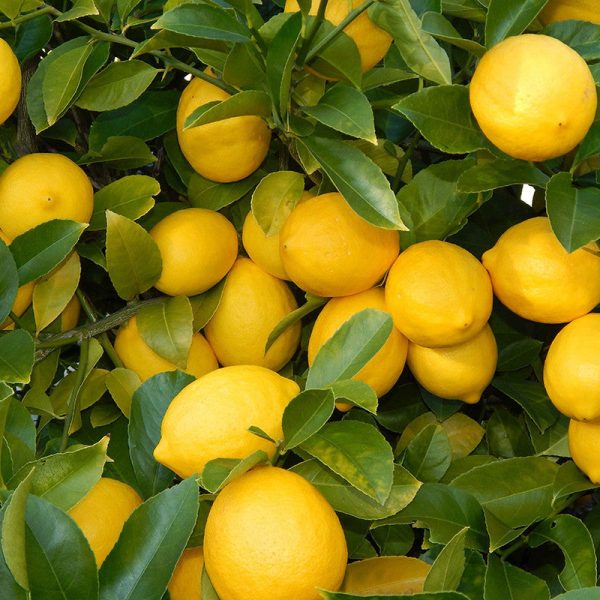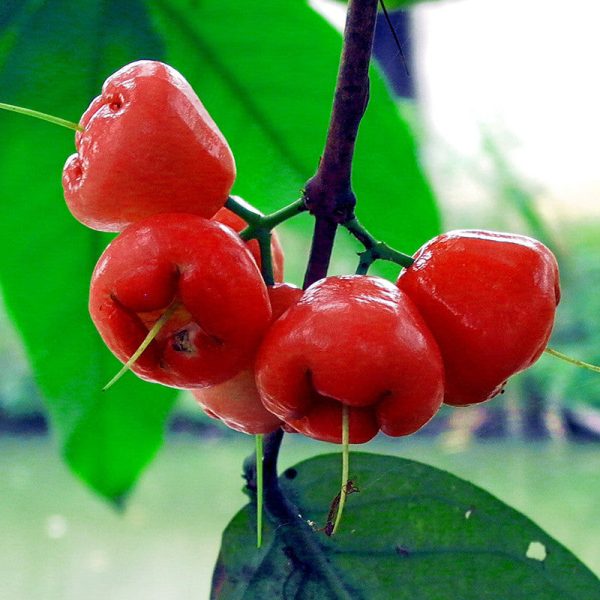Synsepalum dulcificum or “the miracle berry” is a fascinating West-African shrub. It produces fruit that when eaten, blocks or modifies your sour taste bud receptors and makes acidic (sour) foods, taste sweet.
If you manage to get your hands on a Miracle Berry, chew the pulp (roll it around on your tongue), plant the seed, and then explore the world of altered taste for the next 30-45 minutes. Popular things people try eating include: citrus (like lemons or limes), but I encourage you to really explore the limits. Try other things like beer, wine, pickles, vinegar, rhubarb, onions, radishes, and spicy foods.
Thankfully, the miracle berry plant is relatively easy to grow as a houseplant indoors, but it does have some specific needs for success. In this post, I’ll share with you how I grew my two plants from seeds to flowering miracle plants, including care and considerations for how you can grow them in your home.
If you want to see photos of my plants over the last 3 years, skip to the very bottom of this post where I’ve tracked the progression of my plants in a reverse timeline.
Tips for Growing Synsepalum dulcificum From Seed
3 primary things to know about growing the Miracle berry from seed:
1) The plant requires very acidic root conditions (3.5-5pH)
2) The seed viability is short (after you expose the seed to air and it starts to dry, the embryo apparently don’t last much longer than day or two); and
3) When grown from seed, they are initially slow taking nearly a year to produce only half-a-dozen leaves. Under bright artificial grow lights, you may be able to get faster growth. Generally with good culture they can fruit in about 2 years and you’ll see a sharp increase in growth rate after the first year, especially in the second and third years.
I have grown my 2 miracle berries from seed…IN CANADA!
Planted at the end of August 2017, my seeds germinated 4 weeks later on Sept 25, 2017. Two years after that, one of my plants flowered for the first time but didn’t start producing miracle berries until another 6 months. I’ve created this post to help share my experience with others who would like to grow this plant at home as well – and if I can do this in Canada…no matter where you are, you should be able to grow the plant too (assuming you can meet it’s basic requirements).
Grow Miracle Fruit Indoors – with Low pH and High Acidity
pH DOWN! Synsepalum dulcificum needs acidic root conditions
It all starts from seed; Synsepalum dulcificum is reportedly very difficult to germinate, often having a germination rate of less than 10%. Of the two seeds I had, both sprouted (100% germination) and I attribute that to keeping my soil pH VERY low (~4pH) from the very start. Since writing this post, I have found that if you plant the seeds immediately after eating the pulp, you can get near 100% germination—I’m not sure why other sites have found such poor germination. Perhaps it just needs acidic soil to encourage germination, or maybe the seeds used were old?
How do you get your pH low? Well…*don’t laugh*, I started acidifying my potting mix by adding over-fermented kombucha (which essentially results in acetic acid or vinegar). That kombucha vinegar had a pH of about 2.5-3 (too low on its own), so I would adjust the pH of my tap water (which pH ranges from 7.4 – 7.9pH depending on the time of year) to about 4 by mixing tap water and the kombucha vinegar. First I’d add fertilizer, then 1/4 kombucha, topping it up with 3/4 tap water, then I’d check the pH and adjust as needed, and once the pH was 3.5-4.5, I’d water the plants. After a few months of brewing and using my own kombucha, I opted for something less laborious.
pH Update #1 – Phosphoric Acid: From spring of 2018 through to fall 2019, I used phosphoric acid (often sold as “pH Down”) to lower the pH. It required about 30 drops in 1/2 a gallon (2L) to bring the pH of my tap water to a pH of 4. Unfortunately though, I ended up getting a bad bottle of ‘pH Down’ and it caused significant problems across my entire collection of plants and I have since stopped using phosphoric acid.
pH Update #2 – Organic Acid: Fall 2019, I started using organic acids to lower my pH (my own ‘pH Down’ recipe of: citric, fulvic, humic, and carbonic acid). Since switching back to organic acids, the Miracle Berry jumped forward in size, doubling it’s height in a 6-month period. It’s possible this is due to the maturity of the plant and not related to the type of acids used. Either way given the inconsistency with phosphoric acid products, I recommend others just be careful and critical when choosing pH Down options; in a bind citric acid can work well, though some brands have residual sugar which can result in excessive fungal growth in the soil. You can use vinegar -acetic acid- if you’re in a pinch, but I strongly recommend under-dosing and would not use this repeatedly for a long term because vinegar for pH Down can result in some plant growth issues.
Photo showing a considerable size jump after I switched to organic acids to lower pH
pH Tip: When it comes to pH adjustment, don’t guess. Buy a pH meter, be precise and test the pH each time before you fertilize. A pH meter will likely cost you about ~$100 for a digital one, but litmus paper will do the trick to get you into the general area of 4.5pH.
Why do some fruiting plants like the Miracle Berry need low pH?
It comes down to nutrient availability. At a low pH, micronutrients (like iron & manganese) and macronutrients (like ammoniacal nitrogen) are abundantly available; meanwhile, micronutrients like calcium and magnesium may be less common to find in acidic soils. The details are a bit complex, but the takeaway is this: fruit plants like the miracle berry and blueberries which thrive in acidic soil, are adapted to unique conditions to produce fruit and do well. To grow them, you need to offer the conditions they are adapted to. Trying to grow them in alkaline conditions (high pH, low iron, etc) will make the leaves yellow, brown, and could eventually kill the plant—acidifying your water and using an acidic potting mix is how you can prevent this and target success.
For more about pH and plants: If you want to know the grueling details of pH and it’s relationship to plant growth, read this post I wrote on tap-water pH adjusting. Understand, you can’t really challenge the chemistry of plants…so rather than ignoring pH, set yourself (and your Miracle Berry) up for success and just lower your pH.
Caution: Most other plants need a pH of ~5.8-6.5pH, so don’t go acidifying all your plant’s water down to 4pH. Overly acidic conditions like this can and will eventually kill most other types of plants.
Synsepalum dulcificum Care & Cultivation
High Humidity? Miracle Berry Climate
Many care sheets about growing Synsepalum dulcificum say the plant requires high humidity to grow well. That is not true—they do not need high humidity.
The plants originate in “West Africa” (which has high variation in climate depending exactly which area you’re referring to). “S. dulcificum is the most widely distributed, covering Ghana, Benin, Nigeria, Cameroun and Congo” [Source]. Given that good percentage of Ghana (and West Africa) is seasonally quite dry it should be no surprise that the Miracle Berry is adapted (or at least can tolerate) dryer conditions.
Analysis of Synsepalum dulcificum’s climate – “West Africa”

Regardless of speculation, you can take it from my own experience that Miracle berries DO NOT NEED HIGH HUMIDITY! My climate here in Alberta, Canada sucks. Today (April 8, 2019) the humidity is 17%. It’s frequently below 40% and it’s rarely exceeds 50%. My plants grown well and are far easier than many other types of tropicals I grow. I have come to find that good hydration, consistent irrigation cycles, well-balanced nutrition, root aeration and adequate light are key for success with this plant (and most others) rather than obsessing about humidity.
While the Miracle Berry plant is also reportedly quite drought tolerant, ensure that new plants and/or newly-repotted plants are acclimated with care. After repotting, keep roots evenly moist and avoid any severe droughts which may cause new growing root tips to abort preventing the plant from establishing in the new pot or your home.
If you’re like me and are growing in a dryer climate too, focus on keeping the soil acidic and moist at all times and avoid extremes of dryness or prolonged wetness. This means you should be watering as the potting mix approaches dryness but avoid bone dry, dusty or continuously-wet and muddy conditions.
Miracle Berry Substrate / Potting Mix
You want an acidic potting media which is both moisture retentive but also porous, airy and well draining for root health. Something as simple as 50% peatmoss to 50% perlite will work (it’s what I use for seedlings), but your climate (airflow, humidity, brightness and temperature) will alter the rate at which your potting mix dries and you should adjust your ratios to match your watering schedule. Add more peatmoss for less frequent watering and/or add more perlite for faster drying.
Ideally, you’ll want a potting mix that requires water every 5-10 days. If you’re finding you only have to water the plant every two weeks, then the potting media is either too dense and compact or the pot is too large. In these cases, you should add more perlite, consider a smaller pot OR try using a terracotta pot instead of a plastic pot (which will dry the media out faster). If you have to water every 3 days, then it’s not water-retentive enough and you should add more peatmoss (or consider a larger pot which will also slow the drying rate of the substrate).
For my oldest plants, I have a “magic mix” tropical plant substrate that I use, which is a blend of lots of things—you don’t need to go this far, but I like it so that’s why I’m sharing what I use. Bottom line: you want a water-retentive potting mix that drains well and prevents soggy and stagnant root conditions. If it’s too wet and has poor airflow, you can risk root rot which can kill the plant.
Fertilizer & Nutrients
I provide 2 fertilizers:
- Organic (3-5 times per year, 1/4 teaspoon sprinkled over the potting media or mixed into the potting mix on when the plants are repotted). My organic fertilizer is a blend of rock-dust, bloodmeal, and bat guano and it breaks down over many weeks.
- Synthetic (1/4 strength at every watering – 1/4 teaspoon per gallon of acidified water)
Typically I’ll use my MSU Orchid Fertilizer which is well-rounded with micro nutrients and I buy it in bulk (but I’ve also used many other formulas 12-8-8, others 20-20-20, etc). The goal is to keep a consistent flow of nitrogen going through the pot in addition to the organic fertilizers. - Iron – this is a new addition as of winter 2020. I purchased a “Lucky Iron Fish” (which is typically used for cooking), and placed it in the soil. When acidic water interacts with iron it dissolves it making a small amount available to the plants. Many acidic areas of South America and Africa have soils high in iron (hence the red color), so I added this as an educated guess on the plant’s needs. I don’t know that I would recommend this to others, but I have noticed an increase in growth rate.
Light!
It’s reported that Synsepalum dulcificum can grow in full sun; however, it’s a tropical shrub and will likely do better in partial shade or full sun that has been filtered by a sheer cloth. My plants grow in front of a South-facing window and they appear to “get direct sun” from sunrise to sunset; however, my Canadian windows are triple-pane (to keep winter out) and they reflect a lot of light so I suspect they get about 50% full sun.
They are a fruit crop and harvest energy from light to produce berries, so you should grow yours as bright as possible before you see leaf issues (chlorotic spotting/ yellowing or other discolorations).
Growth Cycles & Flowering Synsepalum dulcificum
The Miracle Berry plant seems to follow a seasonal growth pattern; however, depending on your climate and conditions you may find they just grow continuously and produce fruit year-round.
I have found they tend to have stem growth and “reach, stretch and branch” in the winter and spring, followed by a “bush up with leaves” during late spring and summer. In the winter/spring growth, the main stalk and branches can increase the plant’s height by over 50-100% but they tend to look a bit spindly until the leaves fill in. This growth cycle seems to mirror their natural climate and the wet/dry seasons of West Africa; starting with seed germination in fall/winter around Sept-Jan (around the “dryer season”), followed by foliage in summer (wetter season), then branching & flowering in future winters (dry season). Fruits should develop from early spring to summer and be dropping near the end of growth season restarting the cycle again, but again, this may depend on your climate.
How long does it take Synsepalum dulcificum to mature and flower?
It takes about 2-3 years for a plant to grow from a seed to a fruiting size plant which will typically be over 1.5 feet tall. My plants started flowering almost exactly 2 years after the seeds germinated; however, the flowers did not form berries for the first 6 months after flowering began. In spring 2020, I finally had my first berry and progressively the plant produced more with each successive fruiting.
Flowering
Plants that are mature will produce flower buds from the previous year’s branches and trunk. Notes from a newly-discovered related species, Synsepalum chimanimani (which grows on the opposite East side of Africa) says that those plants begin flowering at the end of the dry season and the beginning of the rainy season. As I noted above, this seems to align with my experience for Synsepalum dulcificum as well. A few flowers are produced mid-winter with prolific buds starting at the end of December, followed by peak-flowering in early spring through summer.
Miracle Fruit Buds, Flower, and Early Fruit
(Yes, there are Mealybugs in there too)



How to Pollinate Miracle Fruit Flowers
Given the enclosed form of the flower, pollination is often via self-fertilization but I had better luck with fertilization when I had two plants flowering at the same time. I have seen a few videos on YouTube about shaking the bushes by hand or using an electric toothbrush to vibrate the branch—I didn’t have great success with these methods.
To pollinate a miracle berry flower: wait until you see the stigma protrude from the bud and then take a toothpick and insert it into the flower and run it around the stigma (the “stick” sticking out of the flower). You will see pollen falling out of the flower. Then take the toothpick and run it up and down the stigma and be sure to hit the tip as well. Do this with all open flowers—recognize though, the flowers don’t actually “open” like normal flowers—when you see the stigma protruding from the flower, it is time to pollinate. You may also want to repeat this action daily for the following 2-3 days to ensure pollination has been completed at the correct time (when pollen is actively being produced and the stigma is receptive).
Fruiting the Miracle Berry
I have read, fruits take about 90 days to mature after being pollinated; however, that timeline seems to vary depending on the source. My plants go from pollinated flower to ripe fruits in about 5-6 weeks (35-42 days); however, there may be additional factors that influence the ripening period of miracle berries. Once the berry turns red, you should wait about another 7-10 days for a better “flavour trip” when consuming; but the berries only last on the plant for about 21-28 days.
Fruit drop: It’s reported that premature fruit drop is common—I have experienced this if there are too many flowers pollinated at once. I suspect this is either related to the plant’s “capacity” (how much fruit can one tree produce before it’s too taxing on the plant?) or it’s related to poor nutrient availability (too high of pH, lack of nitrogen and possibly lack of iron??). To help with this, I’m using a broad range of organic ferts and to increase iron, I’ve added a “food grade” iron fish (mentioned above in the fertilizer section).
Photo of Miracle Berry Fruit Tree
That pretty much covers my experience growing miracle berries from seed to fruiting plants. I have taken many photos of my plants over the past couple of years—to see them, keep scrolling…
Photos of Miracle Berry Seedlings Grown Indoors
This is a reverse timeline of my Miracle berries (most recent photos first, down to the oldest when I first germinated the seeds). You may notice two sets of seedlings in the older photos: the short ones are the miracle berry seedlings and the taller ones are sour sop seedlings that I planted on the same day—it gives you an idea of the difference of growth speed of the two fruit trees.




















Reviews
There are no reviews yet.